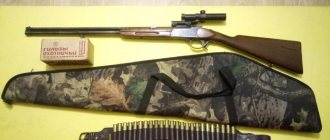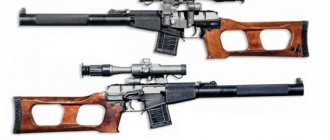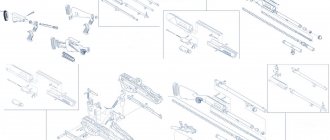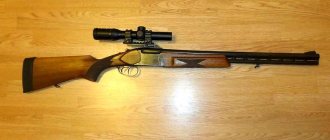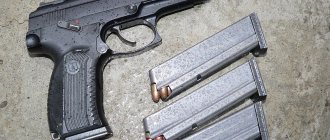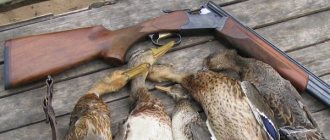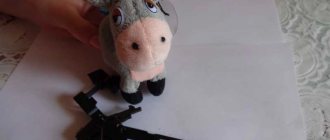Domestic industrialists have long used carbines chambered for 5.6LR and rifles of all known calibers to hunt fur-bearing animals. Intricate fur hunting forced hunters to sometimes carry two guns across the taiga at the same time - a shotgun and a small gun, which was completely impractical. This problem has been tried many times. In fact, a weapon should not only be comfortable, but also inexpensive: cost is always important for people. That is why single-barreled guns, offered at an affordable price, became the basis for experiments in the USSR. Before the appearance of the Izh-56 “Belka” combination shotgun, there were other mechanisms, but it is this that is considered a real present for hunters.
Characteristics
The Izh-56 sample has the following characteristics - it is a “fracture”, in which the detachable barrels are located vertically, which contributes to the most optimal shooting of bullets. The locking here is single, lever, carried out by the bolt hook: in the under-barrel hook there is a recess into which it fits. If we take into account the small recoil of the calibers used, we can say that this scheme is justified. The weight of the gun varied from 2.9 (without optics) to 3.15 (with optics) kg.
When opening the Belka hunting rifle, you need to press the lever located behind the trigger guard. In order for the rifle to close easily, you also need to press the locking lever. Its trigger is identical to the Izh-K and Izh-17 versions, equipped with one trigger and a single external hammer that allows firing from both barrels. When choosing a barrel, you need to switch the trigger using a push-button selector.
Agree, the Belka hunting rifle is great! If its switch is in the rear position, the shot is fired from the lower barrel, in the forward position - from the upper barrel. Under the selector, respectively, the letters “H” and “B” are read. For each barrel separately, two striking protrusions are made in the front part of the trigger.
The Belka (gun) does not have a special safety device: it is equipped with a safety cocking mechanism, on which the trigger is placed after the release - it is impossible to release it from this position. If you are using an optical sight, you will feel comfortable cocking the pawl because its spoke is bent to the right. Trigger force – 2.0-3.5 kg.
By the way, the Belka combination shotgun cannot open when the hammer is cocked. Also, if the product is unlocked, it is not possible to cock the hammer.
The rifle barrels are connected by three couplings: muzzle, breech and sighting. The fine-caliber rifled barrel has a connection that is made by pinning and using a press fit. It is equipped with six right-hand rifling with a pitch of 400 mm. The shot barrel has a “sliding” fit and its bore is chrome plated.
Extractors are located in the breech coupling. A dovetail is milled on its upper part, which is necessary for installing the optics bracket. The standard 2.5x PVS-1 sight is easily removed. Typically it is installed at the factory.
It should be noted that this sight is not effective, although it is quite reliable. The removable forend is equipped with a latch and side cheeks that close the inter-barrel space in the breech of the barrels. The butt of the Belka-3 shotgun is amazing: it is made in the best English traditions. Birch has always been used to make the forend and butts of this model. The swivel is located on the butt and shot barrel (in the area of stepwise modification of the barrel outline).
The open sight of this gun for hunting was moved to the sighting coupling, since the automatic switching of the rear sight position in height was eliminated. It received a folding additional rear sight, designed for shooting from a rifled barrel up to fifty meters. By moving the sight to the coupling, the aiming line was reduced (from 725 to 500 mm).
The third version of the Belka, which has some shortcomings, nevertheless turned out to be a very successful hunting rifle, fully meeting the requirements of industrial hunting. The production of this product was completed more than forty years ago, but its structure and performance properties are not outdated today.
Design
Structurally, the Belka is not much different from the classic over-and-under shotguns produced by IZHMEKHOM. However, given the fact that the weapon is a sideflint weapon, the engineers could not do without some changes that would adjust the existing parts to the hybrid mechanism. Here are the main structural parts and their brief description:
- Bed. Made in a classic rifle style with a straight shape. Only the best varieties of birch or beech were used to produce the wooden part. Additional ergonomics of the weapon is provided by a rubber butt pad.
- Trunks. Both are made of high-quality weapon steel with a high carbon content (marked A50). This metal undergoes a cold hardening procedure, so it has additional strength. The inside of the barrels is chrome-plated.
- Chamber. Divided into two parts - for a rifled and smooth barrel. In the first case, its length is only 50 millimeters, in the second 70 millimeters. The breech is also chrome plated for added strength and durability.
The trigger mechanism deserves special mention, which has undergone some improvements in this version of the weapon. Here are some examples:
- firing pin - presented in the form of a piercing capsule with a front striker made of steel and differs from previous versions in that it is located in the inner part of the bolt;
- mainspring - serves to transfer the necessary energy to the firing pin at the moment of firing - its strength has increased compared to previous models of guns;
- the sear - the mechanism for cocking the trigger into the firing position - did not undergo any serious modifications, but began to work much more reliably;
- trigger - began to be produced in a single version for two barrels;
- intermediate parts - various traction levers, pins, couplings and other mechanisms that ensure fixation and operation of the trigger - there are fewer of them for easier disassembly.
Thus, the design of the IZH-56 really does not represent anything super-outstanding. The only thing that catches your eye is the presence of one trigger for two barrels. However, hunters could also see such a system on modifications of various double-barreled shotguns marked “1C”.
"Squirrel" in the hands of a hunter
What else is “Belka” famous for? The gun has a smooth barrel, which should have been equipped with a “pressure cylinder” drill. But constant cleaning has eradicated the conical drill: now it is smooth and cylindrical. A slight narrowing was felt at an interval of 1/5 of the barrel length, starting from the muzzle, in addition, it looked like a smooth and long cone (about 10-12 cm). At the muzzle, the barrel diameter was 13.5 mm. Taking into account the diameter of the Izhevsk 28-caliber barrels (13.8 mm), we can talk about a weak choke constriction.
The completely non-standard “dovetail” of the optics mount has a surface with a specific knurling that eliminates glare and facilitates arbitrary aiming of the weapon. The base of the front sight was made in a similar way. A barrel with a cylindrical drill produces an excellent uniform sheaf of shot.
The rear sights of the product at 25 and 50 m are sighted and cored at the factory. There were no major anomalies in the horizontal STP, but the vertical deviations had some deficiencies.
Development
32 caliber "squirrel" shotgun: technical characteristics
For the manufacture of IZH-56 barrels, the developers used special 50A grade weapon steel. This alloy has fairly good ductility and strength. To ensure that the entire length of the barrel did not lose these characteristics, the metal was subjected to heat treatment.
In the small arms of the Kazan Arms Plant, special brass soldering was used to connect the barrels together. Since the IZH-56 is equipped with hardened barrels, it is simply impossible to repeat such technology. Therefore, a press fit was used to attach the handguard, swivel and couplings to the post. In addition, all samples are equipped with smooth pins that protect the trunks from possible displacement during planting.
In 1956, a 32-caliber barrel was manufactured at the Izhevsk Arms Plant. For this purpose, a special cylindrical drill with a Paradox choke was used. Thanks to this narrowing, the weapon showed excellent results during field tests when firing a bullet. But the rifled barrel had the opposite effect. Engineers noted that at a distance of more than 35 meters, not all the shot, but about 35% of the charge, hits the target, whose diameter is 75 cm. Therefore, it was decided not to use the Paradox system during the creation of rifled barrels.
Masterpiece
Many people like Belka. The gun is a true masterpiece of engineering. This design is very well designed and executed. This absolutely finished product is a pleasure to hold in your hands! Its outlines are graceful, the system is polished with amazing quality.
Here you can admire just the processing of metal surfaces of weapon elements! But today, with such high-quality metal processing, IZHMEX produces only custom-made samples. "Belka" is a serial gun.
What changed
The main external features of the gun were inherited from the ancestor, but all internal characteristics were radically changed:
- The Anson-Delay mechanism, which was the basis of the IZH-49, was thoroughly redesigned. He received more modern lower sears, which subsequently made it possible to make the block stronger.
- The chrome trigger indicators have also undergone changes, which have moved from the sides of the block to its upper part, moreover, they have become lighter and noticeably more visible in the twilight by finger sensations.
- The firing pins were separated from the triggers and moved to chrome-plated fire tubes.
- The automatic fuse has become more reliable and easier to use.
If you look at the IZH model 1954 gun as a whole, it has grown from the outdated Sauer into a modern and functional gun, going down in history as a completely new weapon and at the same time retaining all the positive qualities of its German ancestors.
The gun received the number in its name from 1954, in which its production began. The weapon was produced for 15 years, until 1969.
Transformations and features
The Izh "Belka" gun was modified by engineers of the 50s: its weight was significantly reduced and it weighs no more than three kilograms! “Excess” metal has been eliminated in many places: the smooth barrel has a stepped contour, holes are drilled in the under-barrel hook, and parts of the sighting devices look like toy ones. At the same time, there is a feeling of absolute reliability of the weapon.
Hunting guns of this model, despite their purpose and design, always affect a person to a certain extent. This nuance is expressed by both associative-subjective and objective factors. For example, for any shooter and weapon lover, the “Belka” is a common interesting design. In fact, it is considered outdated, has a huge number of shortcomings and is unsightly in appearance. Some hunters consider this product a youthful dream. They even perceive the shortcomings of the system from a different perspective, because a dream should not have flaws. Of course, almost everything is forgiven to your beloved gun, like a long-awaited baby.
History of creation
During the Great Patriotic War, all arms factories concentrated their efforts on the production and improvement of samples suitable for the front. Over the years, engineers and workers have accumulated extensive experience in creating weapons. After victory in World War II, the size of the Soviet army decreased significantly
After this, gunsmiths had the opportunity to pay attention to the needs of the common population, in particular, commercial hunters, since the extraction of fur-bearing animals was still carried out using small guns and shotguns
It was quite impractical to take two weapons with you on a hunt at once, so Soviet gunsmiths faced a difficult task. It was necessary to develop a fundamentally new model of firearms that could fire both shot and bullet. In addition, such weapons had to be easy to use and also be inexpensive.
The development of IZH-56 (“Belka”) began in the mid-50s of the last century. The engineers planned to create a bullet-shot weapon with twin barrels. A few years later, a real work of art in weapons craft appeared before Russian hunters.
Loading
In order to charge the Belka, you do not need to make any special efforts. The algorithm here is as follows: we press the lever from below with our right hand, with our left hand we slightly press from above on the middle part of the barrels - the carbine is opened. We insert the cartridges, press the lever again, smoothly close the gun, cock the hammer - the device is loaded.
From which barrel the shot will be fired depends on the position of the switch, that is, the fire selector. The operation pattern and location of the switch are such that the subconscious perceives it as a fuse. And you need to get used to this nuance. Of course, you definitely need to get used to a gun that is equipped with an optical sight. It is here that the convenience of the trigger spoke, specially bent to the right, is revealed.
Third option
Squirrel
Shotgun IZH-56 12 gauge (see photo below). This weapon is intended exclusively for hunting large game. It has a small spread of shot, which allows you to kill an adult boar even from a smooth trunk. According to gunsmiths, changing the caliber should have played a huge role in improving accuracy, and they were right. From now on, the weapon made it possible to fire from a distance of 50 meters or more not only from the lower, but also from the upper barrel.
In addition, the Belka was also equipped with a PVS-1 optical sight, the magnification of which was 2.5. The sighting device was installed on a special removable bracket. It was possible to purchase a weapon with a stock made of birch or beech. The wooden stock was considered essential, since plastic absorbed recoil quite poorly and often broke.
Shooting process
Shooting from the Belka at targets revealed an interesting logic. Small targets the size of a matchbox can only be reliably hit with a small rear sight at a distance of 25 meters. At 50 meters the target fits completely into the sight slot.
If we take a general approach to shooting from a rifled barrel, we must take into account that shots at small targets like hazel grouse or squirrels are possible at a distance of up to 30 meters. In this case, no optics are required. At distances of up to 50-60 meters, you already need to use optics or another sight, for example, a collimator.
That is why the owner of such a rifle will always be faced with the problem of sighting devices. Perhaps a solution using optics on an easily removable bracket is the best option.
If the gun is used only for fur hunting, the scope can never be removed. When hunting for a fur-bearing animal, in fact, one does not shoot at random, even from a shotgun. If you plan to go hunting, you will have to carry the optics separately. After all, it is here that shooting offhand is a very common occurrence. A reasonable maximum for a rifled barrel is considered to be a distance of 70-75 meters. And for smooth – up to 40 meters. Real distances are considered to be 25-30 meters.
Modifications
Review of an innovative Italian shotgun
The IZH 56 shotgun comes in three variants:
- "Belka" 28 caliber - first designed in 1956. Equipped with one trigger. Using the switch, the user changed its location so that the trigger struck the desired cartridge. To fire with the upper barrel, the switch was moved forward; if there was a need for the lower rifled barrel, the switch was moved back. Similar actions could be performed in any position of the trigger. The vertical barrels were removable, they could be changed quickly, for which the fore-end was disconnected and the levers that locked the barrel channels were opened. To ensure that there was no vibration when shooting and the gun gave good accuracy, the barrels were connected by three couplings. The existing ejector, designed to remove empty cartridges, caused some inconvenience, but at the same time simplified the design features of the gun. The length of the barrel located on top was 65 - 72 cm, it had no rifling, was loaded with a cartridge with a 7 cm sleeve. The element located below reached 45 cm in length, was loaded with a rimfire cartridge, and had rifling. The difference in size was compensated by a thin-walled cylindrical tube, which became a continuation of the lower rifled barrel. All internal surfaces are chrome plated, the weight of the gun is 3.15 kg. From numerous reviews, it appears that this version of the shotgun is accurate;
- IZH 56-2 – structurally it is almost no different from the first model. The main difference is that the cylindrical tube is replaced by a casing made by stamping. The thirty-two mm barrel was reduced by 7.5 cm, which reduced the total weight of the gun to three kilograms;
- “Belka-3” is the third version of the IZH 56. It is distinguished from the first two models by the 22 LR barrel mounted on top. As gunsmiths assure, such a design feature should have a positive effect on the accuracy of firing bullets. Additionally, the model is equipped with PVS-1 optics mounted on a removable type mount.
Each of the three options is distinguished by straight stocks made of birch or beech materials.
Effective shooting
During shooting, the shortcomings of the Belka shot trigger appear, it is too rough, without any “pull”. This nuance negatively affects shooting accuracy. By the way, loading weapons and removing spent cartridges is very easy here. However, the only inconvenience is the small size of the “small” cartridge, the manipulation of which, especially in winter frosts, can be difficult.
When opening fire from a rifled barrel, you hardly feel the recoil. And firing from a shotgun seems quite noticeable.
The accuracy of fire from a rifled barrel here is quite good, considering the hard trigger. Of course, bullets from different manufacturers show different results. It turns out that the Belka must be zeroed for a specific type of ammunition.
In general, the 28-caliber Belka gun shoots effectively if the method of equipment and the type of bullets are selected. As a result, at a distance of 30-40 meters you can successfully catch both medium and small animals.
Description
The IZH 56 shotgun is represented by one of the versions of side flints with a vertical arrangement of the barrel pair, for the connection of which soldering is not used. The barrel and breech of each are equipped with couplings.
The barrel on top is smooth and chambered for a 32 mm cartridge. In addition, the Belka gun is also produced in 28 caliber. The lower rifle is adapted for firing bullets. The receiver and locking devices of the IZH 56 Belka gun were very similar to Kazansky’s products. But the main difference from other products with barrels located vertically or horizontally is that the IZH 56 is provided not by a pair of triggers, but by a single one. This design change was made in order to simplify the entire system of the hunting rifle and reduce the costs associated with manufacturing.
Price
Today, our society has realized the value of items from the past, so purchasing old rare weapons in excellent condition is a good investment. Many hunters like the Belka gun. Its price is 600 dollars. The product can be purchased from some owners for 45 thousand rubles.
Izh-56-3 “Belka” is an extraordinary gun with pronounced design features. In general, “Squirrels”, “frolovkas” and other exotics are in the niche of special weapons, which today are not suitable for most popular types of hunting. But many shooters are not looking for their “Squirrel” in order to get food or make a living from the fur trade...
How does the gun work?
IZH-56 have only one trigger and trigger. The receiver contains a special vertical groove in which the trigger switch is located. It operates under the influence of an intermediate rod, which is activated by a button located in the rear part of the receiver. It is locked in the extreme position by a locking pin. In order to move the button, the arrow must first be pressed on the pin.
In the forward position of the button, the trigger interacts with the upper striker, and in the rear position, with the lower one. This button, in addition to switching the trigger, also affects the rotating rear sight - adjusts its position. In order for the owner of the IZH-56 to have the opportunity to perform zeroing independently, the weapon designers decided to install the rear sight on a special base adapted for lateral movement. For this purpose, the weapon is equipped with a special groove. The location of the mechanism responsible for moving the rear sight was the inside of the receiver.
Izh-27
Let's study another interesting device. Izh-27 is a Soviet double-barreled hunting rifle designed for amateur and commercial hunting. It was developed under the leadership of A. A. Klimov and has been mass produced since 1973.
Izh-27 – a deep update of the Izh-12 gun. The shape of the forend and stock was modernized, a ventilated sighting bar was introduced, and the contours of the box were changed at the points where it was attached to the stock.
The gun has been produced since September 2008 under the name MP-27.
Today, more than 1.5 million Izh-27 rifles of various models have been manufactured - this rifle is the most common in Russia.
Story
During the Great Patriotic War, the arms industry concentrated all its efforts on fulfilling exclusively military orders. During this time, workers and weapons engineers have accumulated a lot of experience. Soon after the Victory, the number of orders for the Soviet army decreased significantly. Now gunsmiths have the opportunity to pay more attention to the needs of civilians, namely commercial hunters, who, when hunting fur-bearing animals, were forced to continue to use both a shotgun and a “small gun” at the same time. Since it was very impractical to take two guns with you every time, Soviet gunsmiths were required to develop a new combined model of hunting small arms, which, in addition to being convenient, was also supposed to be cheap.
Work began in the mid-50s. It was planned to create a new bullet-shot weapon with vertically paired barrels. Soon, Soviet weapons engineers gave hunters and commercial hunters a real gift - the Belka combination gun.
Evolution of weapons
In 1957, the same Pugachev created a new gun, IZH-57. However, this did not lead to the closure of the old model. Quite the contrary! The new gun was produced in a small quantity (only 20 thousand pieces), but it became an experimental weapon on which various new developments were installed. As soon as customers liked these innovations, they were immediately installed on the IZH-54.
Also, throughout production, many innovations were added that were developed specifically for the IZH-57. These innovations include the hammer release mechanism, which was transferred from one gun to the second almost immediately after the 57th was put into operation.
Also, in connection with the production of IZH-57, new, more modern barrels and fire tubes were installed on the 54 model.
On early models of IZH-54, strikers were installed that protruded from the solid mirror of the block when the triggers were pulled. It was believed that triggers without a release made it difficult for the system to open the gun after shots. The system was replaced with a more modern version from the 1957 model.
Gun design features:
- triple locking barrels;
- durable steel box;
- hardened parts of the mechanism;
- thickened barrels, which made it possible to use a powerful charge for shooting;
- a common extractor for both barrels;
- the trigger releases easily and smoothly;
- quick assembly and disassembly of weapons.

